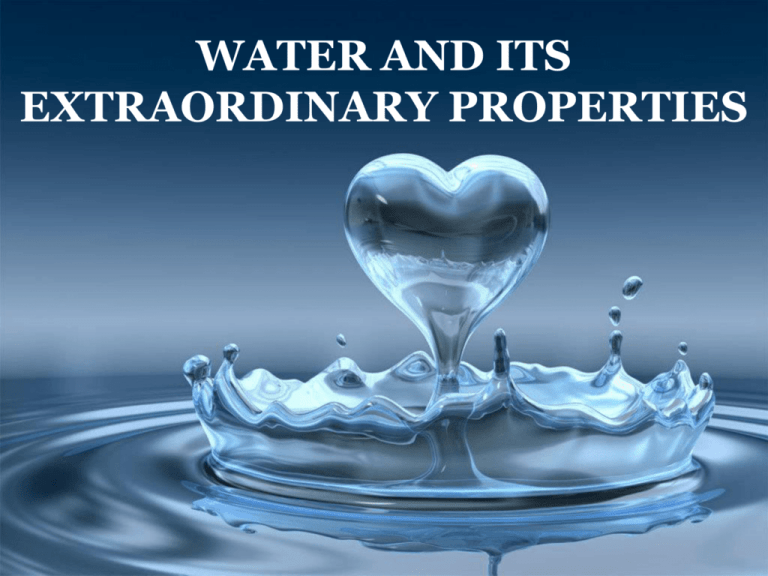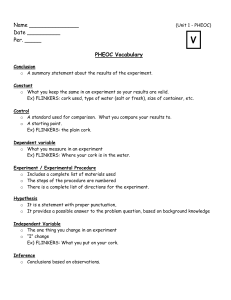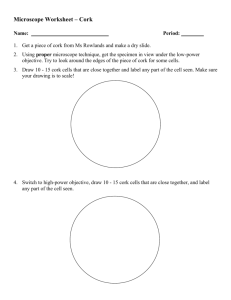
WATER AND ITS
EXTRAORDINARY PROPERTIES
WATER JOKE!!
If H2O is the formula for water,
what is the formula for ice?
Take a guess.
How much of Earth’s surface do
you guys think is covered with
water?
Water is almost everywhere!
It is the most abundant
compound in most living things.
Chemical Structure of Water
Water is made up of two elements:
two hydrogens and one oxygen
They are joined together by covalent bonds.
Property #1: Water is polar
Definition of polarity:
An uneven distribution of electrons between
the oxygen and hydrogen atoms
So in water, there is an unequal sharing of
electrons between the hydrogen and
oxygen molecules.
Still don’t get why water is
polar?
In the molecule, oxygen is greedy and takes
more of its fair share of electrons. Because
oxygen is an electron hog, it slightly pulls the
electrons closer to itself.
That is why the hydrogen end of a water
molecule is positive and the oxygen end is
negative. It has two opposite poles.
However, water overall is neutral, meaning it
has a zero net (total) charge.
The Water Molecule
•As a result, the oxygen end of the molecule has
a slight negative charge and the hydrogen end
has a slight positive charge.
Copyright Pearson Prentice Hall
Covalent Bonds vs. Hydrogen
Bonds
Although the hydrogen and oxygen in the water
molecule itself is joined together by covalent
bonds, the individual water molecules are
hydrogen bonded to one another.
Covalent bonds are much stronger than
hydrogen bonds. That is why it is easier to
break apart water molecules from one another
than it is to break apart a single molecule into
its individual parts.
Property #2: Cohesion
Definition of cohesion:
An attraction between molecules of the same
substance.
Because of hydrogen bonding, water is
extremely cohesive.
Cohesion results in a high surface tension for
water. This produces something called a
surface film.
This explains why some insects and spider can
walk on a pond’s surface (surface film).
Pepper Demo
What happened to the pepper when the
detergent was added to the water?
Why did that happen? (Apply and
explain the property of cohesion in
your answer)
Pepper Demo
What happened to the pepper when the
detergent was added to the water?
The pepper moved away from each other when
the detergent was added.
Why did that happen? (Apply and
explain the property of cohesion in
your answer)
Pepper Demo
What happened to the pepper when the
detergent was added to the water?
The pepper moved away from each other when
the detergent was added.
Why did that happen? (Apply and explain
the property of cohesion in your answer)
The detergent broke the hydrogen bonds between
the water molecules, causing the pepper to
move away from the detergent when dropped.
The water molecules were no longer attracted to
each other because the hydrogen bonds were
broken.
http://www.youtube.com/watch?v=nIR759w
Ijdg
Property #3: Adhesion
Definition of adhesion: a
an attraction between molecules of different
substances
Explains how tops of trees get their water.
Water goes through the roots of the trees
and than “climbs” its way up to the top.
We call this capillarity….
http://www.youtube.com/watch?v=mc9gUm1mMzc
String Demo
What did you see happening to he water
when poured down the string?
Why did that happen? (Apply and
explain the property of adhesion in
your answer)
String Demo
What did you see happening to he water
when poured down the string?
The water did not spill and ran down the string.
Why did that happen? (Apply and
explain the property of adhesion in
your answer)
String Demo
What did you see happening to he water
when poured down the string?
The water did not spill and ran down the string.
Why did that happen? (Apply and
explain the property of adhesion in
your answer)
The water molecules were attracted to the
molecules in the string, allowing for it to
climb down the string.
Cork Demo
What happened to the cork when the cup
was half full? Where did the cork reside?
What happened to the cork when the cup
was overfilled? Where did the cork
reside?
Which property of water explains which
part of the demo?
Cork Demo
What happened to the cork when the cup
was half full? Where did the cork reside?
The cork resided near the sides of the inside of
the cup.
What happened to the cork when the cup
was overfilled? Where did the cork
reside?
Which property of water explains which
part of the demo?
Cork Demo
What happened to the cork when the cup
was half full? Where did the cork reside?
The cork resided near the sides of the inside of
the cup.
What happened to the cork when the cup
was overfilled? Where did the cork
reside?
The cork resided in the middle of the cup.
Which property of water explains which
part of the demo?
Cork Demo
What happened to the cork when the cup
was half full? Where did the cork reside?
The cork resided near the sides of the inside of
the cup. Adhesion
What happened to the cork when the cup
was overfilled? Where did the cork
reside?
The cork resided in the middle of the cup.
Cohesion
Which property of water explains which
part of the demo?
Property #4: Water is less dense
as a solid
Unlike most substance, water expands as it
freezes. Thus, ice is less dense than liquid
water, which explains why ice floats on
the surface of lakes and rivers.
Nemo, I have a
question.
If water was
denser as a solid,
what would
happen to our
marine life?
Well Dory… we
would die. If ice
were to sink to the
bottom of the
ocean, we would
not be able to
survive the cold of
the winter. It
would be
disastrous.
Oh. Cool! But,
Nemo, I have a
question.
If water was
denser as a solid,
what would
happen to our
marine life?
Example:
Putting can of coke in the freezer.
What happens?
Example:
Putting can of coke in the freezer.
What happens?
It explodes
Why?
Example:
Putting can of coke in the freezer.
What happens?
It explodes
Why?
Because the water in it expands.
Example:
Putting can of coke in the freezer.
What happens?
It explodes
Why?
Because the water in it expands.
Property #5: Water is the only
molecule that exists as all 3 states
of matter naturally.
Evaporation:
Condensation
Freezing
Sublimation
Precipitation
What are those?
Property #5: Water is the only
molecule that exists as all 3 states
of matter naturally.
Evaporation: going from a liquid to a vapor
Condensation:
Freezing
Sublimation
Precipitation
What are those?
Property #5: Water is the only
molecule that exists as all 3 states
of matter naturally.
Evaporation: going from a liquid to a gas
Condensation: going from a gas to a liquid
Freezing:
Sublimation
Precipitation
What are those?
Property #5: Water is the only
molecule that exists as all 3 states
of matter naturally.
Evaporation: going from a liquid to a gas
Condensation: going from a gas to a liquid
Freezing: going from a liquid to a solid
Sublimation:
Precipitation
What are those?
Property #5: Water is the only
molecule that exists as all 3 states
of matter naturally.
Evaporation: going from a liquid to a gas
Condensation: going from a gas to a liquid
Freezing: going from a liquid to a solid
Sublimation: going from a solid to a gas
Precipitation:
What are those?
Property #5: Water is the only
molecule that exists as all 3 states
of matter naturally.
Evaporation: going from a liquid to a gas
Condensation: going from a gas to a liquid
Freezing: going from a liquid to a solid
Sublimation: going from a solid to a gas
Precipitation: When water falls from the sky
Awesome!
Why is this important for us?
Because of this property, water can actually
recycle itself which is important, because we
pollute our water. If it didn’t do that
naturally on its own, we would have polluted
water.
Property #5: Water is a powerful
but NOT a universal solvent
Definition of a solute:
The substance that is dissolved
Definition of a solvent:
the substance in which the solute dissolves
Example
Water dissolves ionic compounds such as NaCl
(Table Salt)
This means that the solute NaCl is soluble in
water.
Example
Water dissolves polar covalent compounds
such as fructose (table sugar)
This means that fructose is also soluble in
water.
Why did these substances
dissolve in water?
Because they are similar to water in that
they are ionic (the NaCl) and polar (the
fructose).
As a general rule, “like dissolves like”
Why don’t nonpolar solutes
dissolve in polar solvents?
Polar molecules are attracted to each other
and form bonds with one another. Because
nonpolar molecules are not attracted to
polar molecules, they are excluded by the
polar molecules and pushed away.
Polar substances are the cool kids leaving
out the nonpolar losers.
Review Video
http://www.youtube.com/watch?v=DAilC0sj
vy0
Last water joke!!
What kind of bears dissolve
in water?
POLAR bears!!
THAT’S ALL!
THANKS







